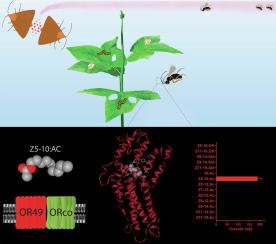Journal of Advanced Research ( IF 11.4 ) Pub Date : 2022-03-07 , DOI: 10.1016/j.jare.2022.03.006 Shuang Shan 1 , Xuan Song 2 , Adel Khashaveh 1 , Shan-Ning Wang 3 , Zi-Yun Lu 4 , Khalid Hussain Dhiloo 5 , Rui-Jun Li 6 , Yong-Jun Zhang 1

|
Introduction
The parasitoid wasp Microplitis mediator is an important natural enemy of the turnip moth Agrotis segetum and other Noctuidae pests. In our field observation, it was fortuitously discovered that sex pheromone traps used for A. segetum also attract female wasps, verified by a simulated field condition dual-choice laboratory assay. Therefore, it was hypothesized that olfactory recognition could be crucial in this process. In this regard, a female-biased odorant receptor of the wasp, MmedOR49, attracted our attention.
Objectives
To unravel the significance of the female-biased MmedOR49 regulating host pheromone recognition.
Methods
Expression analysis (fluorescence in situ hybridization; quantitative realtime PCR), in vitro (two-electrode voltage-clamp recordings) and in vivo (RNAi combined with behavioral assessments) functional studies, and bioinformatics (structural modeling and molecular docking) were carried out to investigate the characteristics of MmedOR49.
Results
MmedOR49 expression was detected in the antennae of females by FISH. Quantification indicated that the expression level of MmedOR49 increased significantly after adult emergence. In vitro functional study revealed that MmedOR49 was specifically tuned to cis-5-decenyl acetate (Z5-10:Ac), the major sex pheromone component of A. segetum. Molecular docking showed that Z5-10:Ac strongly bound to the key amino acid residues His 80, Ile 81, and Arg 84 of MmedOR49 through hydrogen bonding. Behavioral assays indicated that female wasps were significantly attracted by Z5-10:Ac in a three-cage olfactometer. RNAi targeting further confirmed that MmedOR49 was necessary to recognize Z5-10:Ac, as female wasps lost their original behavioral responses to Z5-10:Ac after down-regulation of the MmedOR49 transcript.
Conclusion
Although M. mediator is a larval endoparasitoid, female wasps have a behavioral preference for a sex pheromone component of lepidopteran hosts. In this behavior, for female M. mediator, MmedOR49 plays an important role in guiding the habitat of host insects. These data provide a potential target for enhancing natural enemy utilization and pest control.
中文翻译:

寄生蜂 Microplitis 介导寄主昆虫栖息地中调节鳞翅目性信息素的雌性气味受体
介绍
寄生蜂Microplitis mediator是萝卜蛾Agrotis segetum等夜蛾科害虫的重要天敌。在我们的实地观察中,偶然发现用于A. segetum的性信息素诱捕器也能吸引雌性黄蜂,这一点已通过模拟现场条件双重选择实验室分析得到证实。因此,假设嗅觉识别在这个过程中可能是至关重要的。在这方面,一种偏向雌性的黄蜂气味受体 MmedOR49 引起了我们的注意。
目标
揭示女性偏向的 MmedOR49 调节宿主信息素识别的重要性。
方法
进行了表达分析(荧光原位杂交;定量实时 PCR)、体外(双电极电压钳记录)和体内(RNAi 结合行为评估)功能研究和生物信息学(结构建模和分子对接)以研究 MmedOR49 的特征。
结果
通过 FISH 在雌性触角中检测到MmedOR49表达。量化表明MmedOR49的表达水平在成虫出现后显着增加。体外功能研究表明,MmedOR49 特别针对顺式-5-乙酸癸烯酯 (Z5-10:Ac),这是A. segetum的主要性信息素成分. 分子对接表明,Z5-10:Ac 通过氢键与 MmedOR49 的关键氨基酸残基 His 80、Ile 81 和 Arg 84 强烈结合。行为分析表明,在三笼嗅觉计中,雌性黄蜂被 Z5-10:Ac 显着吸引。RNAi 靶向进一步证实 MmedOR49 是识别 Z5-10:Ac 所必需的,因为雌性黄蜂在下调MmedOR49转录物后失去了对 Z5-10:Ac 的原始行为反应。
结论
尽管M. mediator是幼虫内寄生蜂,但雌性黄蜂对鳞翅目宿主的性信息素成分有行为偏好。在这种行为中,对于雌性M. mediator而言,MmedOR49 在指导宿主昆虫的栖息地方面起着重要作用。这些数据为提高天敌利用和害虫控制提供了潜在目标。











































 京公网安备 11010802027423号
京公网安备 11010802027423号